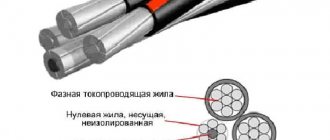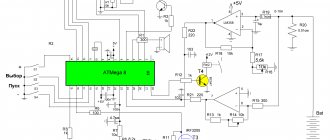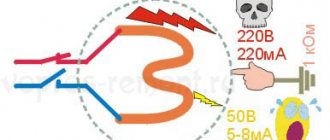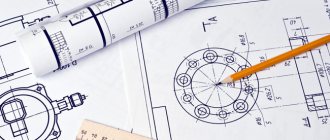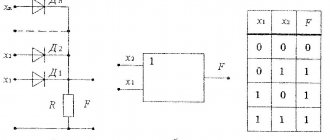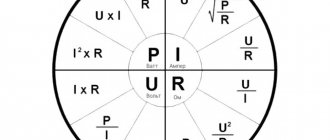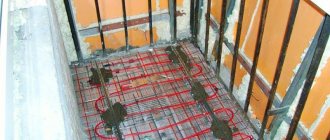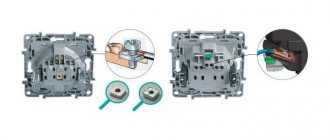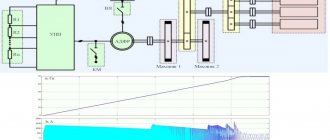Electric heating elements are used in household and industrial appliances. The use of various heaters is known to everyone. These are electric stoves, frying cabinets and ovens, electric coffee makers, electric kettles and heating devices of various designs.
Electric water heaters, more commonly referred to as boilers, also contain heating elements. The basis of many heating elements is wire with high electrical resistance. And most often this wire is made of nichrome.
Open nichrome spiral
The oldest heating element is, perhaps, an ordinary nichrome spiral. Once upon a time, homemade electric stoves, water boilers and “goat” heaters were in use. Having nichrome wire at hand, which one could “get hold of” in production, making a spiral of the required power did not present any problems.
It was known what diameter the wire was and what length was required to wind the spiral of the required power. These magic numbers can still be found on the Internet. The figure shows a table that shows data on spirals of various powers at a supply voltage of 220V.
Calculation of the electric spiral of the heating element
Everything here is simple and clear. Having set the required power and the diameter of the nichrome wire available at hand, all that remains is to cut a piece of the required length and wind it onto a mandrel of the appropriate diameter. In this case, the table shows the length of the resulting spiral. What to do if there is a wire with a diameter not indicated in the table? In this case, the spiral will simply have to be calculated.
Electric boilers
Unlike previous devices, these devices are used to create a permanent heating system in the house. They are used in conjunction with a coolant fluid circulating in a closed circuit connecting all rooms in the house.
Based on the type of main heating element, electric boilers are divided into:
- Heating elements - work with any type of liquid and have the simplest design. They allow you to smoothly change the power and stepwise change the heating intensity by turning on a different number of devices.
- Electrode, which are compact in size and are used exclusively for water systems. In this case, the coolant must strictly comply with the requirements of GOST 2874-82 “Drinking water”. This circumstance greatly affects the cost of the equipment. Thermal energy arises by the principle of electrolytic dissociation, due to which a potential difference arises at the electrodes due to dissolved salts. This heats the water perfectly. This device is much more economical than the previous one.
- Induction boilers are the most innovative and expensive devices. They are very reliable and durable. Such boilers can heat any coolant using the principle of electromagnetic induction. Such a device consumes the maximum amount of electricity, but is easy to install, does not require a separate room and has maximum efficiency with the smallest dimensions.
All electric boilers must be grounded very reliably.
All types of electric boilers
How to calculate a nichrome spiral
If necessary, calculating the spiral is quite simple. As an example, the calculation is given for a spiral made of nichrome wire with a diameter of 0.45 mm (this diameter is not in the table) with a power of 600 W at a voltage of 220 V. All calculations are performed according to Ohm’s law.
First you need to calculate the current consumed by the spiral.
I = P/U = 600/220 = 2.72 A
To do this, it is enough to divide the given power by the voltage and obtain the amount of current passing through the spiral. Power in watts, voltage in volts, result in amperes. Everything is according to the SI system.
Using the now known current, calculating the required resistance of the spiral is quite simple: R = U/I = 220/2.72 = 81 Ohm
Formula for calculating conductor resistance R=ρ*L/S,
where ρ is the resistivity of the conductor (for nichrome 1.0÷1.2 Ohm•mm2/m), L is the length of the conductor in meters, S is the cross-section of the conductor in square millimeters. For a conductor with a diameter of 0.45 mm, the cross-section will be 0.159 mm2.
Hence L = S * R / ρ = 0.159 * 81 / 1.1 = 1170 mm, or 11.7 m.
In general, the calculation is not so complicated. In fact, making a spiral is not that difficult, which is undoubtedly an advantage of ordinary nichrome spirals. But this advantage is offset by many disadvantages inherent in open coils.
First of all, this is a fairly high heating temperature - 700...800˚C. The heated coil has a faint red glow; accidental touching it may cause a burn. In addition, electric shock may occur. A hot spiral burns out the oxygen in the air and attracts dust particles, which, when burned out, give off a very unpleasant aroma.
But the main disadvantage of open spirals is their high fire hazard. Therefore, the fire department simply prohibits the use of heaters with an open spiral. Such heaters, first of all, include the so-called “goat”, the design of which can be seen in the video.
This is how the wild “goat” turned out: it was made deliberately carelessly, simply, even very poorly. You won't have to wait long for a fire with such a heater. A more advanced design of such a heating device is shown in the figure below.
PET type heater 1 kW, 220 V
It is easy to see that the spiral is covered with a metal casing; this is what prevents contact with heated live parts. The fire hazard of such a device is much less than that shown in the previous video.
Once upon a time, reflector heaters were produced in the USSR. In the center of the nickel-plated reflector there was a ceramic socket into which a 500W heater was screwed, like a light bulb with an E27 socket. The fire hazard of such a reflector is also very high. Well, somehow they didn’t think about what the use of such heaters could lead to in those days.
Reflex heater
It is quite obvious that various heaters with an open spiral can, contrary to the requirements of the fire inspection, be used only under close supervision: if you leave the room, turn off the heater! It’s even better to simply stop using this type of heater.
Electric heating elements
The operation of electrothermal devices is based on the conversion of electrical energy into heat when current passes through a conductor. The power of the devices depends on the current, voltage and resistance of the conductor. Current conductors are divided into metallic (metals), nonmetallic (coal, graphite, etc.) and liquid (electrolytes). They are widely used in catering establishments
metal current conductors: nichrome (alloys of nickel and chromium) and fechral (alloys of iron, chromium and aluminum). These alloys have high resistivity, do not undergo oxidation at high temperatures and do not change their mechanical properties during sudden temperature fluctuations. Their service life at temperatures of 600–1000°C is more than ten thousand hours.
The materials that insulate the metal current conductor from the body of the thermal apparatus are electrical ceramics, mica, porcelain, magnesium oxide (periclase), micanite, and perlite. These materials have high dielectric properties, are chemically neutral, hydrophobic and have good thermal conductivity.
In electric thermal apparatus of public catering establishments, hermetically sealed (without air access), closed (with air access) and open electric heating elements, as well as infrared lamps, are used.
The most widely used are hermetically sealed tubular electric heaters (heating elements), made in the form of a tube, inside of which there is a spiral pressed into the insulation. The tubes are made of carbon steel with anti-corrosion coating or stainless steel. Additionally, the tubes are coated with aluminum, which increases the service life of the heating elements and reduces scale deposits on their surface.
The spiral is placed in a vertically placed tube so that it does not touch the walls. The space between the spiral and the walls of the tube is filled with periclase. The ends of the spiral are brought out using contact rods. The tube is crimped in such a way as to reduce its diameter to 13 mm, and then filled with heat-resistant varnish (sealant): The shape of the tubular electric heater depends on the location of its installation and the design of the device. For heating devices of public catering establishments, they produce: air heating elements - for heating air in cabinets, water heating elements - for heating water in digesters and other devices, oil heating elements - for heating edible fats in deep fryers. Heating elements are designed to work only in a certain environment. If heating elements operating in water are turned on in air, they will burn out very quickly. In heating devices, heating elements are usually installed in blocks, which allows you to regulate the thermal process of cooking.
Currently, electric heaters with a quartz glass tube and a tungsten spiral are produced. They serve as a source of infrared energy and can be used for frying kebabs and other products.
The advantages of heating elements include a relatively long service life, compactness, efficiency, and the ability to be used in various environments; The disadvantages are the difficulty of manufacturing and repair.
Closed electric heating elements are used in electric stoves with cast iron burners. The burners on the lower side have grooves in which spirals are laid, enclosed in an electrically insulating mass. Closed heating elements are protected from mechanical damage, but are not isolated from air access, so the coils in them oxidize faster than in heating elements.
Open electric heating elements are nichrome spirals suspended on insulators or placed in grooves of ceramic tiles. Heat transfer from the coil to the heated medium occurs mainly by radiation, which is why such electric heating elements are called radiant. In public catering, they are not widely used, as they have an increased risk of electric shock and a limited service life due to the rapid oxidation of atmospheric oxygen.
Electric heating elements with closed spiral
To get rid of the open spiral, Tubular Electric Heaters - heating elements - were invented. The design of the heating element is shown in the figure below.
Heating element design
Nichrome spiral 1 is hidden inside a thin-walled metal tube 2. The spiral is insulated from the tube by filler 3 with high thermal conductivity and high electrical resistance. The filler most often used is periclase (a crystalline mixture of magnesium oxide MgO, sometimes with admixtures of other oxides).
After filling with an insulating composition, the tube is pressurized, and under high pressure the periclase turns into a monolith. After such an operation, the spiral is rigidly fixed, so electrical contact with the body - tube is completely excluded. The design is so strong that any heating element can be bent if required by the design of the heating device. Some heating elements have a very bizarre shape.
The spiral is connected to metal leads 4, which come out through insulators 5. The supply wires are connected to the threaded ends of leads 4 using nuts and washers 7. The heating elements are secured in the device body using nuts and washers 6, ensuring, if necessary, the tightness of the connection.
Subject to operating conditions, such a design is quite reliable and durable. This is what led to the very widespread use of heating elements in devices of various purposes and designs.
Tubular electric heating elements
According to operating conditions, tubular electric heating elements are divided into two large groups: air and water. But it's just a name. In fact, air heating elements are designed to operate in various gas environments. Even ordinary atmospheric air is a mixture of several gases: oxygen, nitrogen, carbon dioxide, there are even impurities of argon, neon, krypton, etc.
The air environment can be very diverse. This can be calm atmospheric air or a stream of air moving at speeds of up to several meters per second, as in fan heaters or heat guns.
Heating of the heating element shell can reach 450 ˚C or even more. Therefore, various materials are used to make the outer tubular shell. It can be regular carbon steel, stainless steel, or high-temperature, heat-resistant steel. Everything depends on the environment.
To improve heat transfer, some heating elements are equipped with ribs on the tubes in the form of a wound metal strip. Such heaters are called finned. The use of such elements is most appropriate in a moving air environment, for example, in fan heaters and heat guns.
Water tubular electric heating elements are also used not necessarily in water, this is the general name for various liquid media. This can be oil, fuel oil and even various aggressive liquids. Liquid tubular electric heating elements are used in electric boilers, distillers, electric seawater desalination plants and simply in titaniums for boiling drinking water.
The thermal conductivity and heat capacity of water is much higher than that of air and other gaseous media, which provides, compared to the air environment, better, faster heat removal from the heating element. Therefore, with the same electrical power, the water heater has smaller geometric dimensions.
Sealed heaters
Sealed closed heaters are capable of generating thermal energy in different ways: convection, radiation and conduction. This category of devices includes heating elements. The design of the heating element consists of a thin tubular-type metal shell with a spiral of wire with high resistance. The inside of the shell contains insulating material. Terminals are built into the contact rods.
Sealed heaters also include:
The advantage of this category of heating devices is their high electrical safety, long service life, and the ability to be used in various environments (even the most aggressive).
When choosing a heater, you should focus on such indicators as installation location, desired heating temperature, application environment, heating rate and a number of individual operating factors. Some industries require high-temperature rapid heating, while others require long-term continuous heat supply. Therefore, when deciding on the choice of an electric heater, first of all pay attention not to the cost of the device, but to the requirements for it. Otherwise, trying to save money, you expose yourself to even greater waste. An incorrectly selected device will systematically fail.
All kinds of electrical appliances for heating are widely used in everyday life in almost every home. The main component of such devices are electric heating elements (TEH) (Spiral).
Varieties
There are only two types of heaters:
1. Open electric heating elements: Open type heaters include spirals. Spiral heating elements release heat through convection and radiation. They are basically suspended from a bracket made of electrically insulating material. There are also spirals placed in insulating grooves. 2. Closed electric heating elements: - sealed. Sealed heaters include tubular heating elements. Electric heating elements operate on the basis of convection, radiation and conduction, converting electrical energy into thermal energy; - leaky. These are spirals and tapes in a protective sheath made of electrical insulating material. As protection, scaly ceramic beads can be used, placed directly on the spiral.
Features of heating coils
For the manufacture of heating coils, nichrome or fechral is used. Some companies produce spirals from Eurofechral. Different manufacturers produce heating elements in a zigzag or round shape. There are spirals equipped at the ends with threaded rods (screws).
How to get rid of scale and extend the life of the heating element
In addition to chemical agents, various devices are used to protect against scale. First of all, these are magnetic water converters. In a powerful magnetic field, crystals of “hard” salts change their structure, turn into flakes, and become smaller. From such flakes, scale forms less actively; most of the flakes are simply washed away with a stream of water. This ensures protection of heaters and pipelines from scale. Magnetic filter-converters are produced by many foreign companies; such companies also exist in Russia. Such filters are available in both mortise and overhead types.
Electronic water softeners
Recently, electronic water softeners have become increasingly popular. Outwardly everything looks very simple. A small box is installed on the pipe, from which the antenna wires come out. The wires are wound around the pipe without even having to peel off the paint. The device can be installed in any accessible place, as shown in the figure below.
Electronic water softener
The only thing you need to connect the device is a 220V outlet. The device is designed to be turned on for a long time; it does not need to be turned off periodically, since turning it off will cause the water to become hard again and scale will form again.
The operating principle of the device is reduced to emitting vibrations in the ultrasonic frequency range, which can reach up to 50 KHz. The oscillation frequency is adjusted using the device's control panel. The emissions are produced in packets several times per second, which is achieved using a built-in microcontroller. The oscillation power is low, so such devices do not pose any threat to human health.
The feasibility of installing such devices is quite easy to determine. It all comes down to determining how hard the water is coming from the water pipe. You don’t even need any “abstruse” devices here: if after washing your skin becomes dry, white stains appear on the tiles from splashing water, scale appears in the kettle, the washing machine washes slower than at the beginning of operation - hard water is definitely flowing from the tap. All this can lead to failure of the heating elements, and, consequently, the kettles or washing machines themselves.
Hard water does not dissolve various detergents well - from ordinary soap to trendy washing powders. As a result, you have to add more powder, but this helps little, since hardness salt crystals are retained in the fabrics, and the quality of washing leaves much to be desired. All of the listed signs of water hardness eloquently indicate that it is necessary to install water softeners.
Connecting and checking heating elements
When connecting the heating element, a wire of suitable cross-section must be used. Here everything depends on the current flowing through the heating element. Most often, two parameters are known. This is the power of the heater itself and the supply voltage. In order to determine the current, it is enough to divide the power by the supply voltage.
A simple example. Let there be a heating element with a power of 1 kW (1000 W) for a supply voltage of 220 V. For such a heater, it turns out that the current will be
I = P/U = 1000/220 = 4.545A.
According to the tables located in the PUE, such a current can be provided by a wire with a cross-section of 0.5 mm2 (11 A), but in order to ensure mechanical strength, it is better to use a wire with a cross-section of at least 2.5 mm2. This is the wire most often used to supply electricity to sockets.
But before making the connection, you should make sure that even a new, just purchased heating element is in working order. First of all, you need to measure its resistance and check the integrity of the insulation. The resistance of the heating element is quite simple to calculate. To do this, you need to square the supply voltage and divide by the power. For example, for a 1000 W heater this calculation looks like this:
220*220/1000=48.4 Ohm.
The multimeter should show this resistance when connecting it to the terminals of the heating element. If the spiral is broken, then, naturally, the multimeter will show a break. If you take a heating element of a different power, then the resistance will naturally be different.
Insulation integrity check
To check the integrity of the insulation, measure the resistance between any of the terminals and the metal body of the heating element. The resistance of the filler-insulator is such that at any measurement limit the multimeter should show a break. If it turns out that the resistance is zero, then the spiral has contact with the metal body of the heater. This can happen even with a new, just purchased heating element.
In general, a special megohmmeter device is used to check insulation, but not always and not everyone has it at hand. So checking with a regular multimeter is quite suitable. At least such a check must be done.
As already mentioned, tubular electric heating elements can be bent even after being filled with insulator. There are heaters of the most varied shapes: in the form of a straight tube, U-shaped, rolled into a ring, snake or spiral. It all depends on the design of the heating device in which the heating element is supposed to be installed. For example, in the instantaneous water heater of a washing machine, coiled heating elements are used.
Some tubular electric heating elements have safety features. The simplest protection is a thermal fuse. If it burns out, then you have to change the entire heating element, but it won’t lead to a fire. There is also a more complex protection system that allows you to use the heating element after it has been triggered.
One of such protections is protection based on a bimetallic plate: heat from an overheated heating element bends the bimetallic plate, which opens the contact and de-energizes the heating element. After the temperature drops to an acceptable value, the bimetallic plate unbends, the contact closes and the heating element is ready for operation again.
Oil-cooled radiators
The appearance and principle of operation of such devices are completely similar to ordinary heating batteries. Only they are filled with mineral oil, and they are heated by electric heating elements installed directly inside the internal cavity of the device. They are successfully used in offices and residential premises. There are open and closed oil radiators. The ribs of the latter are protected by a metal casing. The main advantage of these devices is that they do not burn up the oxygen in the room and do not heat up to temperatures dangerous for small children. Especially the last property concerns closed radiators.
Open and closed oil radiators
Tubular electric heating elements with thermostat
In the absence of hot water supply, you have to use boilers. The design of boilers is quite simple. This is a metal container hidden in a “fur coat” of heat insulator, on top of which there is a decorative metal casing. There is a thermometer embedded in the body that shows the temperature of the water. The boiler design is shown in the figure.
Storage boiler
Some boilers contain a magnesium anode. Its purpose is to protect the heater and the internal tank of the boiler from corrosion. The magnesium anode is a consumable item and must be changed periodically when servicing the boiler. But in some boilers, apparently in a cheap price category, such protection is not provided.
A heating element with a thermostat is used as a heating element in boilers; the design of one of them is shown below.
Heating element with thermostat
The plastic box contains a microswitch that is triggered by a liquid temperature sensor (straight tube next to the heating element). The shape of the heating element itself can be very diverse; the figure shows the simplest one. It all depends on the power and design of the boiler. The degree of heating is regulated by the position of the mechanical contact, controlled by a white round handle located at the bottom of the box. The terminals for supplying electric current are also located here. The heater is fastened using threads.
Types of heating elements
An electric convector (there are also gas and water) is the most popular heating device on the market today. It has earned its reputation not only for its ease of use, but also for its reliability. This equipment can provide comfortable conditions both in the living room and in public areas. Experts consider the main feature of the design to be the absence of intermediaries for heat transfer.
A modern convector uses one of three types of heating elements . He can be:
- needle-shaped, ribbon-shaped, stick-type heater;
- a tubular-type electric heater with aluminum fins, abbreviated as heating elements;
- monolithic type.
Each type has its own characteristics and disadvantages. The decision about which one to choose must be made based on the characteristics of the heated room.
Wet and dry heating elements
Such a heater is in direct contact with water, which is why such a heating element is called “wet”. The service life of a “wet” heating element is within 2...5 years, after which it has to be replaced. In general, the service life is short.
To increase the service life of the heating element and the entire boiler as a whole, the French company Atlantic developed a “dry” heating element design in the 90s of the last century. To put it simply, the heater was hidden in a metal protective flask, which prevents direct contact with water: the heating element heats up inside the flask, which transfers heat to the water.
Naturally, the temperature of the flask is much lower than the heating element itself, so the formation of scale at the same water hardness does not occur as intensely; a larger amount of heat is transferred into the water. The service life of such heaters reaches 10...15 years. The above is true for good operating conditions, especially the stability of the supply voltage. But even in good conditions, “dry” heating elements also exhaust their service life and have to be replaced.
This is where another advantage of the “dry” heating element technology is revealed: when replacing the heater, there is no need to drain the water from the boiler, for which it should be disconnected from the pipeline. Simply unscrew the heater and replace it with a new one.
The Atlantic company, of course, patented its invention, after which it began to sell the license to other companies. Currently, boilers with a “dry” heating element are also produced by other companies, for example, Electrolux and Gorenje. The design of a boiler with a “dry” heating element is shown in the figure.
Boiler with a dry heater
By the way, the figure shows a boiler with a ceramic steatite heater. See below for the design of such a heater.
